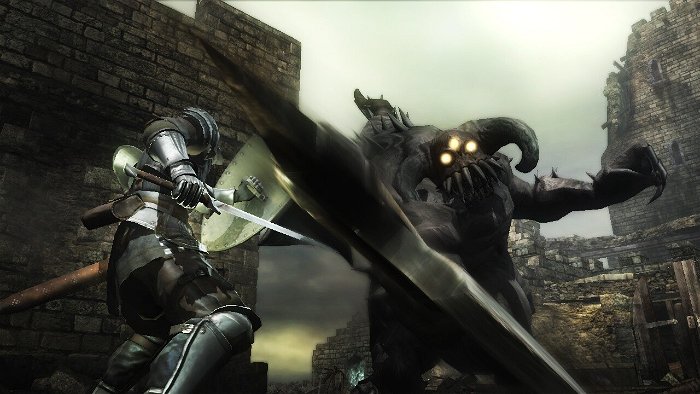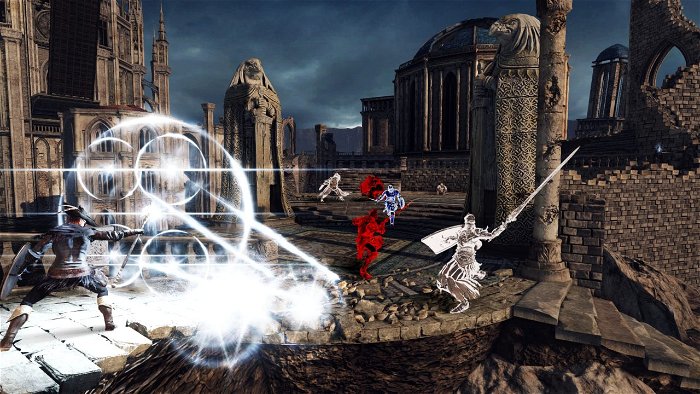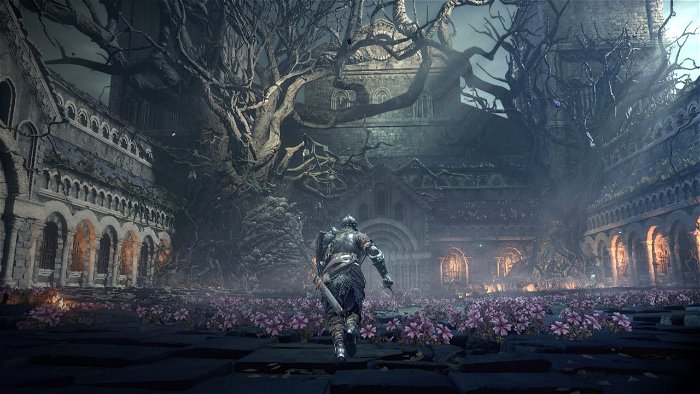Ever since Demon’s Souls took the world by storm back in 2009, the Souls series has quickly become one of the most beloved (and excruciatingly difficult) videogame franchises in modern gaming. Though this might sound a bit ludicrous now, very few people actually paid attention to the first entry in the Souls Bourn series, Demon’s Souls, when it was first released. Its commercial and critical success astounded many, including Sony itself. The company let the series slip from its grasp, and it went from being a PlayStation exclusive to releasing on multiple platforms with the next installment, Dark Souls.
But can you really blame Sony for this blunder?
A game that takes pleasure in punishing its players for every mistake, no matter how trivial, doesn’t seem like it’d jive with the general public—but it did, and in spades. It is hard to look back on that game’s release and think just how big the Souls series would become. Now, with Dark Souls 3 on store shelves and most likely being the last entry for a long while, developer FromSoftware’s series will continue to be a source of inspiration for a slew of game makers and their creations for many years to come and we’re already seeing that come to fruition.

Ska Studios’ punishingly difficult 2D action side-scroller Salt and Sanctuary blatantly copies the Souls games in many respects, but is actually all the better for it. It takes pride in punishing every wrong decision you make, and both critics and players seem to dig the game. With a hand-drawn art style set in a 2D plane, Salt and Sanctuary successfully carries over everything that makes the Souls games so great. Expect a lot more of these types of experiences from other developers in the near future.
Prior to the start of Demon’s Souls’ two-year development period, FromSoftware and the game’s creative director, Hidetaka Miyazaki, wanted to make a new installment in the King’s Field series; a collection of brooding role-playing titles that are mostly set in labyrinthine dungeons. However, Miyazaki convinced the rest of the development team to move away from King’s Field in order to be more creative and innovative with a new IP built from the ground up.

“I am a fan of FromSoftware, but naturally that also means there are parts of their games I’m not satisfied with, too,” said Sony Computer Entertainment Japan producer Takeshi Kajia at the time. “If this was a new King’s Field game, there would be areas we wouldn’t be able to touch since they’re part of the series; working together like this, we can try to make something really new.”
Demon’s Souls
Miyazaki mentioned Ico, the early Dragon Quest games, fantasy-themed gamebooks such as Fighting Fantasy, and manga like JoJo’s Bizarre Adventure as sources of inspiration. The excruciating difficulty of Demon’s Souls was intentionally designed to foster a sense of accomplishment. This game design choice encourages players to form strategies while constantly discovering new things and areas in the game.
The difficulty also heightens the sense of dread, with many locations created to embody man-made evil. The Souls series, including Demon’s Souls, doesn’t focus primarily on a straightforward plot but rather emphasizes mechanics and discovery. They are heavy on environmental storytelling, depicting places corrupted by human lust for power and wealth.
With Demon’s Souls’ critical and commercial success, FromSoftware quickly began work on a spiritual successor titled Dark Souls. It released two years later, in October 2011. While Dark Souls retains mostly everything that made the first title so great, it employs a larger, continuous open world environment to explore, connected through a central hub area called Firelink Shrine. Players are able to travel to and from areas, and have to defeat various ghastly and deadly creatures and bosses. Yes, the game is just as challenging as its predecessor, and also contains a minimalist plot. It’s mostly left up to the player to piece the story together.

There’s also a large emphasis on online play, which allows other players to invade your game, or provide you with precious hints and boosting certain resistances. There are two states in the game: the human form, which opens up online gameplay, and the hollow form, which you become once your character dies. In order to once again become human, you must spend a single “humanity point,” items which are not so easily acquired.
Dark Souls 2
Dark Souls was even more successful than Demon’s Souls, selling 2 million copies in its lifetime as well being nominated and winning several Game of the Year awards. This, of course, expectedly led to a direct sequel in Dark Souls II three years later. Co-director Tomohiro Shibuya said that he and the rest of the development team had no intention of changing the controls in any drastic way, as Dark Souls II plays almost identically to its predecessor.
The game world is roughly the same size in both games, though Dark Souls 2 has a lot more content density and gives players more freedom in how they want to progress. The biggest change here was the fact that FromSoftware utilized a more powerful graphics engine, making Dark Souls 2 the most visually impressive game in the series yet.

While series creator Miyazaki wasn’t involved with Dark Souls 2, he was still busy working on another similar game in Bloodborne. While not a direct sequel to any of the Souls game, it still retains the same gameplay, art style, level design, and storytelling ideas. Action is a lot more fast-paced and reflex-based, moving away from the more methodical and tactical gameplay of Dark Souls. Plus, you can’t carry shields.
Miyazaki first began working on the game after development was completed on the Prepare to Die edition of Dark Souls in 2012. The director wanted to make a game for the next generation of consoles: the PlayStation 4 and Xbox One. The concept for Bloodborne and the ability to build an entirely different game from scratch was developed from this single desire.

The game’s Victorian gothic aesthetic is said to be inspired by the classic Bram Stoker novel Dracula, as well as various locations and architecture from Romania and the Czech Republic. Miyazaki believed that in order to create similar environments and make them as detailed as possible, the game had to be built for the PlayStation 4. As you’d expect, the game performed quite well commercially, selling over two million copies and garnering a healthy critical reception.
Dark Souls 3
FromSoftware went back to its roots a year later by releasing Dark Souls 3, the fourth entry in the series and what is currently believed to be the final Souls game. Miyazaki was back as director and has stated on several occasions that despite working on Bloodborne, Dark Souls 3’s gameplay design followed Dark Souls 2. Shields are back, and so is the much more slower-paced combat and the emphasis on strategy. The game was actually developed alongside Bloodborne, but was handled by a separate team. Miyazaki has stated that because of Bloodborne’s gameplay limitations, he felt a longing desire to work on Dark Souls 3 as he was able to create a game with more variety when it comes to battle styles and features.
With the game now out on PlayStation 4, Xbox One, and PC, one can only wonder what the future holds for From Software and its influential director.
Elden Ring and beyond

With the Dark Souls series seemingly done for now, FromSoftware is ready to embark on the next journey with Bandai Namco. Bringing together Hidetaka Miyazaki and fantasy novelist George R. R. Martin, Elden Ring takes place in the realm of the Lands Between. Similar to past entries from the developer, including Bloodborne and Sekiro: Shadows Die Twice, and the Souls series, this third-person action RPG will task players to fight and explore a once-great land.
With vast areas and creatures waiting to take you down around every turn, this feels very much like the evolution of the series and all FromSoftware has built up to this point. Notably bigger than past entries, Elden Ring is an exciting entry from an already amazing studio that brings some of the best visuals ever seen from the studio.
With Elden Ring already selling over 12 million copies and talk of this being a new franchise, it seems FromSoftware has a whole new world to explore. While Elden Ring is not part of the Dark Souls or Demon’s Souls Franchise, it carries with it all the style, concept and combat FromSoftware is known for. The new open world concept also makes Elden Ring one of the most accessible Souls-like games to date, allowing more people to jump in and experience why the series is so loved. It is hard to say what is next for the Souls series, but with more people playing it daily, it is like we will see much more from the studio in the future, and that should be exciting.




